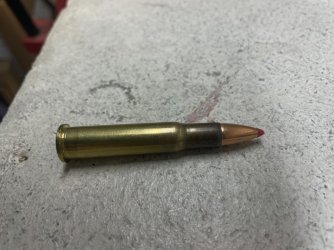Critter Picker
Well-Known Member
Back in the 80's, we took a 2 foot by 4 foot sheet os 3/4 inch plywood. Put it in a CNC mill and plunged 1/4 inch staggered holes . Then we cut wood dowels 12 inches long and put them into the holes. That way we could see what happened when a bullet strikes an object. Even the 45-70 405 grain were affected. There is no such thing as a brush buster.I used to reload for my dads 30-30 Contender when he was still able to hunt. If I recall, it shot the 125 and 150gr NBTs very well at surprisingly high velocities considering it was a 14" barrel. He killed a few deer with it over the years and bullet performance was always good with one exception. He shot a Whitetail and the bullet went through two strands of barbed wire fence before striking the deer. That one took a bit of tracking before we finally found it.
As a friend described it. When a bullet hits anything it acts like a top. There's no way to predict where it will go.

